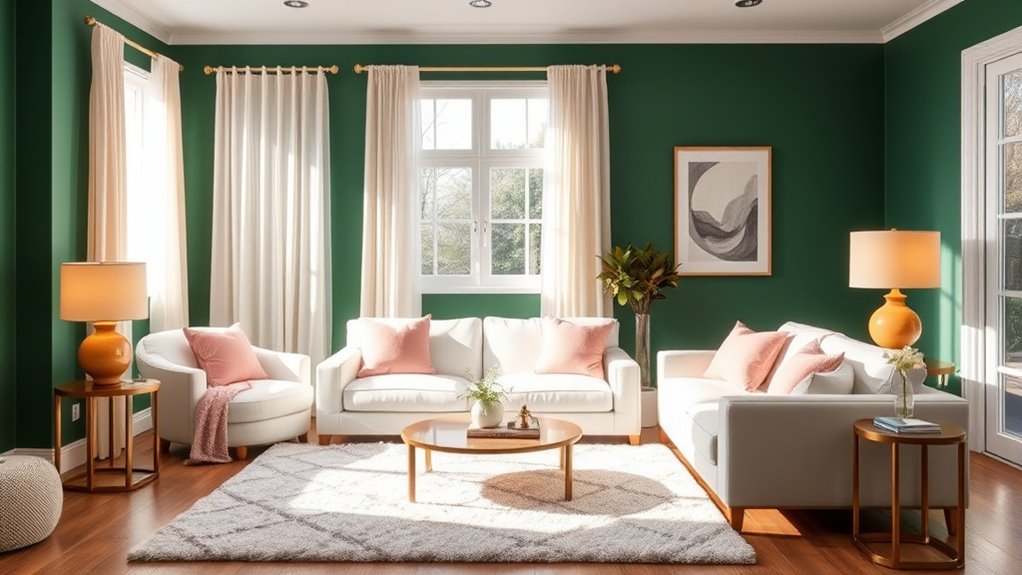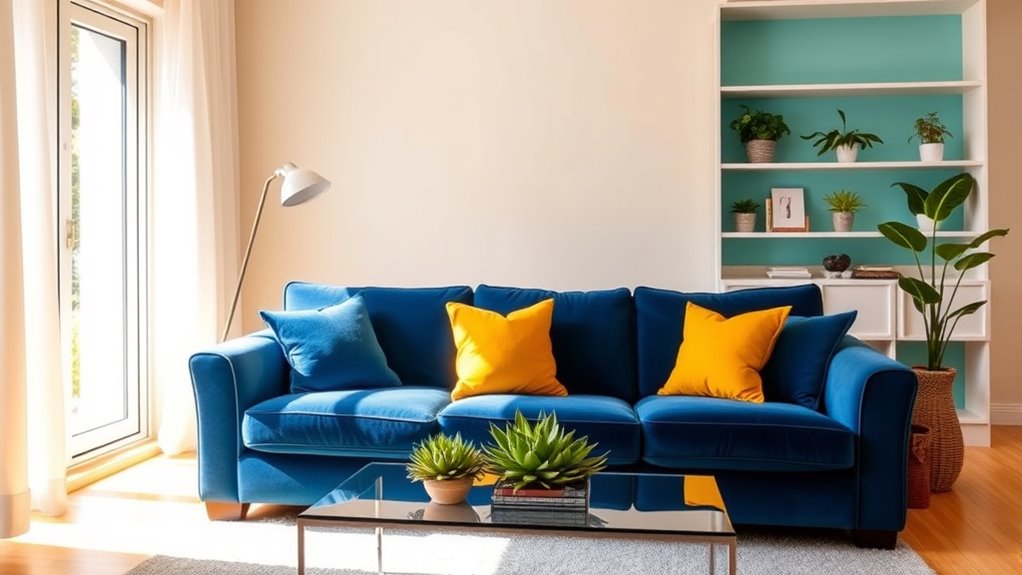Understanding the psychology of color in home décor helps you create spaces that influence your mood and behavior. Colors like blue promote calmness, while green supports balance. Bright hues energize, and muted tones soothe. Use harmonious schemes to foster relaxation or vibrant contrasts to boost energy. By choosing colors aligned with your emotional needs, you can transform your home into a supportive environment. Keep exploring to discover how to apply these insights effectively in your space.
Key Takeaways
- Use calming blue tones in bedrooms to promote relaxation and improve sleep quality.
- Incorporate energizing reds or oranges in workout or dining areas to boost motivation and activity.
- Choose neutral or pastel colors for stress relief and creating a soothing atmosphere.
- Pair complementary colors like blue and beige to enhance harmony and emotional comfort.
- Consider personal preferences and context when selecting colors to support mental and emotional well-being.

Colors in your home do more than just decorate—they influence your mood and behavior. The colors you choose can evoke specific feelings and set the tone for each space. Understanding color associations helps you create an environment that aligns with your intentions, whether you want to relax, energize, or focus. For instance, blue is often linked to calmness and serenity, making it ideal for bedrooms or meditation areas. Green, associated with nature, can promote balance and renewal, perfect for living rooms or home offices. Red tends to energize and stimulate, so it might work well in a dining room or workout space. By paying attention to these color associations, you can design your home to support your emotional well-being.
Your mood influence is a vital aspect of choosing the right colors. If you’re feeling stressed or anxious, opting for soft, muted tones like pastels or neutrals can create a soothing atmosphere. Conversely, if you want to boost motivation or creativity, brighter, more vibrant colors like yellow or orange can invigorate your space. Keep in mind that color impacts not just your feelings but also your behavior. For example, red can increase heart rate and excitement, encouraging activity, while cool shades of blue may slow you down and promote relaxation. Recognizing these effects can help you make smarter choices about where to use certain colors within your home. Additionally, contrast ratio plays a crucial role in how colors appear and interact, influencing the overall harmony of your décor.
It’s important to contemplate how different colors interact with each other in your décor. Complementary and harmonious color schemes can enhance the overall mood you want to cultivate. For example, pairing calming blues with warm beige tones can create a peaceful, cozy environment. On the other hand, contrasting colors like purple and yellow can energize a space, making it feel lively and dynamic. When selecting colors, think about how they will make you feel in different contexts—what works in a workspace might not be suitable for a bedroom if you’re aiming for rest.
Ultimately, understanding color associations and their mood influence allows you to craft home décor that genuinely supports your lifestyle. You get to shape your environment intentionally, using color to foster tranquility, enthusiasm, focus, or any other emotion you wish to experience. Whether you prefer subtle neutrals or bold hues, knowing how colors affect your mood grants you the power to transform your home into a sanctuary that nurtures your mental and emotional health.
Frequently Asked Questions
How Do Cultural Differences Influence Color Perceptions in Home Décor?
Cultural differences shape how you perceive colors in home décor through cultural symbolism and regional color trends. In some cultures, red symbolizes luck and prosperity, while in others, it signifies warning or danger. Your preferences may reflect these cultural meanings and local trends, influencing your color choices. By understanding these cultural nuances, you can create a space that resonates personally and culturally, making your home décor more meaningful and harmonious.
Can Color Preferences Change Over Time Within a Household?
Your evolving color preferences can definitely change over time within a household. As household dynamics shift—like new family members, changing tastes, or lifestyle updates—your preferences may adapt too. You might find yourself drawn to different hues that better suit your current needs or mood. Embracing these changes allows you to refresh your space and create a more harmonious environment that reflects your ongoing evolution.
What Are the Best Colors to Boost Productivity at Home?
Think of your workspace as a garden, where the right colors can grow productivity like vibrant blooms. According to color psychology, blue fosters calm focus, perfect for detailed tasks. Green reduces anxiety and enhances concentration, while yellow sparks creativity. For productivity enhancement, incorporate these hues into your home office; they’ll turn your space into a powerhouse of efficiency and inspiration.
How Does Lighting Affect the Psychological Impact of Colors?
Lighting mood and color temperature considerably influence how colors impact you. Warm lighting creates a cozy, calming effect, making warm colors feel more inviting, while cool lighting enhances vibrant, energetic feelings with cooler hues. When choosing lighting, consider the mood you want to set; softer, warmer light emphasizes comfort, whereas bright, cool light boosts alertness. Adjusting lighting and color temperature together helps you craft the perfect atmosphere in your space.
Are There Specific Colors Suited for Small or Cluttered Spaces?
When choosing colors for small or cluttered spaces, opt for minimal color schemes like whites, light grays, or soft pastels. These colors help create a sense of openness and make your space look larger. Avoid dark or busy hues that can make the area feel cramped. Using light, neutral tones enhances visual space and promotes a calm, airy atmosphere, making your room feel more spacious and inviting.
Conclusion
By understanding the psychology of color, you can create a home that truly reflects your personality and mood. Whether you want a calming sanctuary or an energizing space, choosing the right hues makes all the difference. So, why not experiment with colors that inspire and uplift you? After all, your home should be a place where you feel most yourself—so go ahead, paint your world with colors that speak to your soul.









